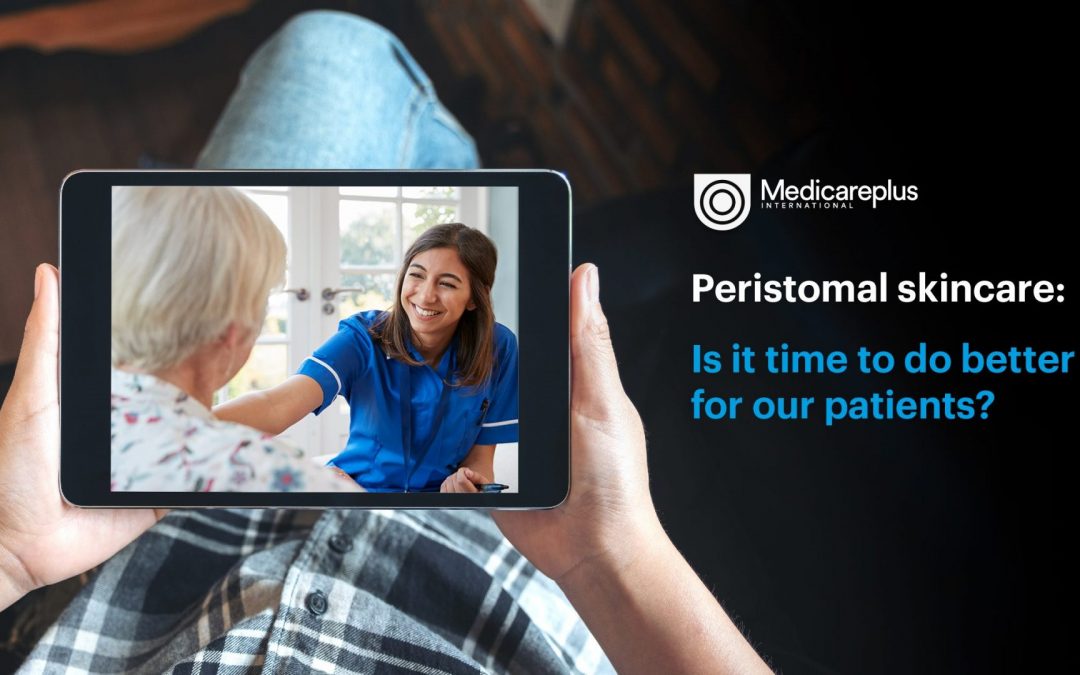

One in 500 people in the UK live with a stoma. Up to 85% of ostomates have experienced common problems such as skin irritation, blockage, leakage, and difficulty attaching and removing appliances, but many do not seek professional help1. One study identified that approximately one third of patients with a stoma who were followed up over a 5-year study period had evidence of skin complications within 90 days of surgery2. This, in turn, leads to increased healthcare costs, increased product use, wastage and unnecessary referrals to specialist stoma services.
Peristomal skin complications vary, with the most common types including peristomal moisture-associated skin damage (MASD), irritant dermatitis, hypersensitivity and allergic responses of the skin, and mechanical damage related to the use of medical adhesives in various pouching systems (MARSI)3.
The skin is the largest organ in the body and performs vital functions to keep the body safe from external forces; Peristomal skin is vulnerable due to regular removal and application of ostomy adhesive pouches and leakage of faecal or urinary fluid4once the skin integrity is broken, it causes pain, risk of infection and reduced quality of life. Preventing moisture-associated skin damage (MASD) must be at the forefront of stoma care management.
Peristomal moisture-associated damage is a known complication of an ostomy; preventative skincare is vital7
MASD is a reportable harm alongside pressure ulcers in the NHS following updated guidance in 2018. NHS Improvement (NHSI) rationale for this change is to capture skin damage that is currently reported inconsistently5. This will help identify the clinical problem within individual trusts and the quality improvement action that needs to be taken to improve outcomes for service users and patients. NHS Trusts are expected to report all categories of MASD on their systems, including peristomal dermatitis; however, from discussion amongst the tissue viability nurse community, it is thought that some only reported incontinence associated skin damage (IAD). With accurate data of incidence and analysis, true quality improvement outcomes can be made.
MASD is classified as an irritant contact dermatitis by The World Health Organisation (WHO)8
The MASD umbrella term is subdivided into key areas as listed in the International Best Practice Recommendation: Prevention and Management of Moisture-Associated Skin damage (MASD)8.
■ IAD
■ Peristomal dermatitis (relating to colostomy, ileostomy/ ileal conduit, urostomy, suprapubic
catheter, or tracheostomy)
■ Intertriginous dermatitis (intertrigo: where two skin areas may touch or rub together)
■ Peri-wound maceration.
Risk assessment and prevention strategies are key in MASD. Interventions can be taken to protect the skin and prevent MASD, including using skin protection products, such as barrier creams, liquid polymers, and cyanoacrylates to create a protective layer on the skin surface that simultaneously maintains hydration levels while blocking external moisture and irritants9.
The following factors increase the risk of developing peristomal dermatitis10.
■ Abdominal anatomy: creasing of the skin when changing positions (standing, sitting, supine);
■ Location of stoma (e.g., in the GI tract);
■ Stoma construction, including the degree of protrusion and position of the lumen on the abdomen;
■ Incorrect pouch, changing technique and wear time;
■ Increased perspiration or exposure to external moisture, which may disrupt base plate adhesion to the skin, allowing effluent to come into contact with skin (e.g. showering, swimming);
■ Incorrect incidence data of types of stoma issues and effective management.
Skin damage due to MARSI can occur in stoma care. The term peristomal medical adhesive related skin injury’ (PMARSI) is an alteration in skin integrity with erythema and skin tears, erosion, bulla, or vesicle, that is apparent after removal of an adhesive ostomy pouching system’1. Skin-stripping (removing or tearing the epidermis with the removal of the adhesive faceplate) is a particularly prevalent form of PMARSI.
It is vital to use advanced barrier and adhesive removal products – such as the Medicareplus International Total Barrier Protection™ package that support protective skincare practises.
Medi Derma-S Barrier Film is a silicone-based, long-lasting, non-sting medical grade liquid which forms a protective uniform film when evenly applied to the skin. Its barrier properties protect damaged and intact skin from the harmful effects of moisture, irritants and from potential skin damage that may be caused from the application of adhesive stoma pouches.
The skin protectant-focused range of products available in various applicators are non-cytotoxic, alcohol-free, hypoallergenic, non-sting even on broken skin and importantly silicone-based, which makes it liquid repellent and conformable to the skin. The barrier film dries in seconds, which is important to patients and service users who have busy, active lifestyles and self-manage day-today.
Skin that is severely damaged from the effects of MASD requires advanced treatment skin protection. Medi Derma-Pro is a skin protectant ointment and foam & spray cleanser which will effectively remove even dried-on bodily fluids and provide long Lasting Protection– Resilient, hydrophobic protective barrier from moisture associated skin damage.
The UK median age for a person with a stoma is 40 years11
The pouching system should be regularly re-evaluated to ensure proper fitting, with the skin barrier suited to the output type. For abdominal stomas, the first line of protection should ensure skin is clean and dry before the application of the pouch while ensuring a good fit and seal8 (i.e., sizing the aperture and fitting with body contours).
Adhesive removal products have evidence to prove that they help to prevent skin stripping from PMARSI8. Acrylate terpolymer barrier films can be used to provide a layer between the skin and the adhesive stoma device. Lifteez Medical Adhesive Removers non-sting, no-rinse formulation is fast and powerful on adhesives but gentle on the skin. Quickly breaking adhesive bonds in a non-sting formula ensures patient safety is at the heart of Medicareplus International products.
With our advanced products, it is no longer necessary to use ‘crusting’ techniques, which involve powders and barriers, layering up of products that need vigorous cleansing to remove. The use of powders and techniques such as these take time, waiting for each application layer to dry.
Skin protection should be considered in patients prone to skin damage and those who have a risk of developing MARSI12
Medicareplus International undertook a focus group of stoma care, colorectal and tissue viability nurses working in the NHS. The group’s experience was that preventative peristomal skincare was not usual, and interventions only occurred when a patient contacted the nurse team with MASD. Lack of education for healthcare staff and patients about the best available products to use was cited as often lacking.
Stoma management is in the realms of self-care, whether the patient carries out interventions or it is done by a family member or carer. Involvement of the healthcare professional takes place immediately after surgery in demonstrating techniques of bag changes, and occasionally in community nursing if a person needs initial additional support. Unlike many other skin inflammatory conditions (such as peri-wound MASD, incontinence associated skin damage, intertrigo, dermatitis and eczema) which usually involve healthcare professional support and use of products for preventative care and close management, peristomal MASD and PMARSI is primarily left to the patients to self-manage, which may be an important reason for why skin protection in stoma patients is less of a focus area.
The concept of self-care is widely discussed in wound care and advocated in the NHS 10-year plan13 for all healthcare professionals through health coaching. Successful self-care has been analysed and has supported care planning with regular check-ins from healthcare professionals, alongside education on product use via supporting literature. Education is at the heart of this approach and is vital for its success.
Ongoing support in education delivered in a variety of formats is what our clinical specialists at Medicareplus International excel in.
COVID-19 has caused significant disruption to the delivery of patient care across the globe14.
One UK hospital-based stoma nurse team reflected on the impact of COVID-19 on their services15. Before the pandemic in February 2020, they had 82 face-to-face clinic contacts and made 31 home visits. All services were suspended in March 2020 in line with the Government’s recommendations, and staff were redeployed to ward duties. The stoma clinic services resumed in the summer of 2020, but with less than half the previously available appointments due to COVID-19 restrictions in place. Remote telephone consultations for patients with any issues became part of routine service.
While evidence of increased peristomal MASD due to COVID-19 is not yet available, it would certainly be expected, and therefore, the education and pathways of preventative skincare need to be in place for patients, so that they do not suffer from sore excoriated skin and the associated impacts on quality of life.
References


We aim to manufacture innovative, economic, patient-centric solutions for chronic conditions that improve quality of life, whilst helping clinicians around the world improve clinical outcomes.
